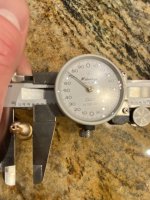Recently decided to fall down the 8.6blk rabbit hole. Have been following this thread, and seeing what seems to be working well for others.
.
Here’s what’s worked for me, and what hasn’t.
.
I’ve had great success with converting Hornady .243 & 6.5CM brass. Neck wall thickness comes out right where I want it.
.
Good results with Accurate 1680 powder.
.
Good results with Barnes TTSX 160gr, and 185gr bullets. Also with Sierra Match King 300gr bullets.
.
Issues I’ve ran into. Converting Lake City 308 brass. As others have mentioned necks have to be turned. My issue was using my Hornady Neck Turner the brass wouldn’t fit on the .338 mandrel. Thought I found a way around turning the necks after wasting $1000+ dollars buying brass on gun broker that’s converted from lake city without having the necks turned, and supposed to be ready to load. That didn’t work out well.
( Search 2A_CaliGuy on YouTube to see what I mean)
However the idea of reaming the necks got me thinking. So I ordered a custom ground reamer, and decided to try again.
.
My new process for converting my Lake City 308 is.
.
Anneal all brass first.
(1.) Size all brass with RCBS 308 FL small base sizing die in station 1 on Dillon CP-2000.
(2.) Swage dreaded Crimps on station 2.
(3.) Size using 8.6 FL sizing die in station 4.
(On the CP-2000 the 8.6 is too short to be in station 3, and requires the short trim tool head

)
(4.) Trim using Trim die, and RT-1500 in station 6 (Trimmer manifold blocks station 5.)
(5.) Chamfer/Debur.
(6.) Expanded Case mouth using 8.6blk Expander from LEE die in sacrificial LEE Beowulf die.
(7.) Ream Case Mouth using custom Reamer.
(8.) Turn Necks now that they fit the darn Hornady Mandrel.
(9.) FL Size in an 8.6 die with expander removed.
(10.) Load and check in Sheridan Split Gauge.
(11.) Shoot, and hope to have a more pleasant time reloading now that the hard parts been done.
.
So you may ask why on earth I’d want to go through all the trouble to make some brass. Simple LC 308 brass here is $0.10ea, but Hornady .243/6.5cm is hard to find once fired, and is usually $0.50+ ea. New Hornady brass because has been close to $1 ea. I haven’t seen any 250pc , 2000pc Hornady available for a long time. Don’t get me wrong if I could find Bulk Hornady brass I’d take that route. Also I found out I could fit 500 loaded 300gr SMK rounds in the plastic ammo cans from Walmart if I stack them ridiculously neatly

. What free time, and dedication will do to a guy.
.
Anyways I’ve got some videos of my chronograph results, and some videos on my process on YouTube. My username is the same as my channel name.














